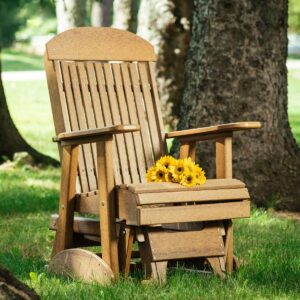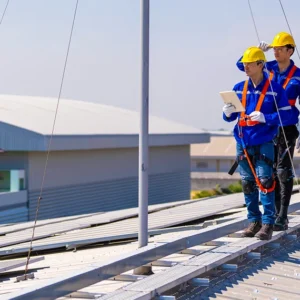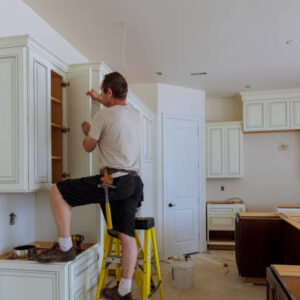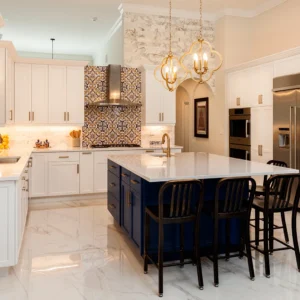1. Teak – Naturally Durable and Weather-Resistant
Teak wood is one of the most trusted materials for outdoor furniture, especially in unpredictable climates. Thanks to its high natural oil content, teak resists moisture, mildew, and insects better than most woods.
It also holds up well under sunlight and fluctuating temperatures. Over time, teak develops a lovely silver-gray patina, or you can maintain its golden tone with regular oiling.
Ideal for: All climates, especially those with strong sun, humidity, or rain.

2. Aluminum – Lightweight Yet Tough
Aluminum, particularly powder-coated aluminum, is an excellent option for extreme weather. It won’t rust like steel or iron, making it great for coastal or humid regions. It’s also lightweight and easy to move, yet strong enough to handle daily use.
When choosing aluminum outdoor furniture, look for reinforced frames and UV-resistant coatings for longer life and better performance in direct sunlight.
Ideal for: Hot and humid regions, coastal areas, and windy zones.
3. HDPE Wicker – Synthetic Strength and Style
Traditional wicker may look charming, but it doesn’t hold up in rain or heat. That’s where high-density polyethylene (HDPE) wicker comes in. This synthetic alternative mimics the aesthetic of real wicker but is UV-resistant, moisture-proof, and doesn’t crack or fade.
Many high-quality outdoor sets use HDPE woven over aluminum frames for a balance of beauty and performance. You can find durable all-weather wicker furniture options designed specifically to resist harsh elements for years.
Ideal for: Sunny, humid, or variable climates.
4. Steel and Wrought Iron – Heavy and Resilient
Steel and wrought iron are both known for their strength and wind resistance. However, without protective coatings, they can be susceptible to rust. Powder-coating helps minimize corrosion and makes maintenance easier.
If you live in a place with strong gusts or storms, heavy-duty wrought iron chairs or tables won’t blow away easily. Just be sure to add cushions and weather-resistant covers for comfort and protection.
Ideal for: Windy or storm-prone regions.
5. Recycled Plastic or Polywood – Eco-Friendly and Weatherproof
One of the rising stars in the outdoor furniture industry is recycled plastic (often known as polywood). It mimics the look of wood but doesn’t rot, peel, or splinter. It’s UV-stable, water-resistant, and requires almost no maintenance.
For homeowners who prioritize sustainability and low upkeep, high-performance recycled plastic furniture is one of the smartest long-term investments.
Ideal for: All climates, especially where minimal maintenance is preferred.
Fabric Choices That Make a Difference
Materials aren’t just about the frame. The cushions and upholstery you choose also matter for surviving extreme weather.
Look for:
-
Solution-dyed acrylic fabrics like Sunbrella that resist fading, mold, and water
-
Quick-drying foam cores that won’t retain moisture
-
Removable cushion covers for easy washing or replacing
Waterproof covers can also help prolong the life of your outdoor furniture, especially during winter or rainy seasons.
Design and Functionality Tips for Weather-Resistant Outdoor Furniture
Choosing weather-resistant materials is only half the battle. Consider these functional tips when designing or arranging your furniture:
-
Opt for modular or foldable pieces if you plan to store them in bad weather.
-
Use heavy bases for umbrellas and tables to prevent tipping in high winds.
-
Avoid glass tops in hail-prone or icy areas—they can shatter easily.
-
Add storage benches or deck boxes to keep cushions and accessories dry.
Also, think long-term: Will this furniture survive through multiple seasons without needing replacement? Prioritize longevity and not just initial cost.
Storage and Maintenance Tips for Harsh Weather Protection
Even the best outdoor furniture will benefit from occasional care and off-season storage:
-
Use protective covers year-round when furniture isn’t in use.
-
Clean regularly with mild soap and water to prevent mold or grime buildup.
-
Reapply sealants or oils (especially for wood pieces) annually.
-
Store cushions indoors or in waterproof bins during winter or extended rain.
-
Stack or fold light items and place them in a shed or garage during storms.
Balancing Style and Durability
Many assume that choosing weatherproof furniture means compromising on style—but that’s no longer the case. Today’s market offers sleek, modern, and rustic designs in every material type.
From warm wood tones and earthy weaves to bold metallics and soft pastels, your outdoor furniture can be just as chic as your indoor decor. Add throw pillows, rugs, lighting, and planters to complete the look while maintaining weather-resilience.
Choosing Wisely for Long-Term Outdoor Living
Your outdoor space should be a haven, no matter the weather. That’s why investing in outdoor furniture that can handle sun, rain, snow, and wind is essential for both comfort and cost savings over time.
By focusing on strong materials like teak, aluminum, HDPE wicker, and recycled plastic, and pairing them with durable fabrics and smart design, you ensure your furniture will stand the test of time—and nature. Whether you’re dealing with blistering summers or snowy winters, well-chosen outdoor pieces will stay beautiful and functional for years to come.
And if you’re ready to upgrade your patio or deck, consider choosing furniture built specifically for all-season durability through thoughtfully selected weather-resistant outdoor seating and dining pieces.





